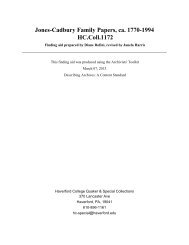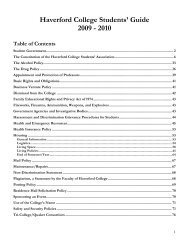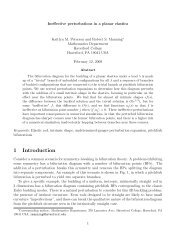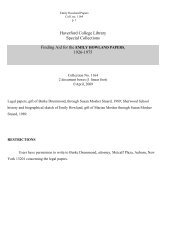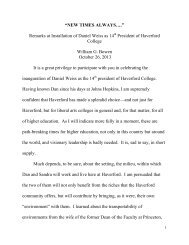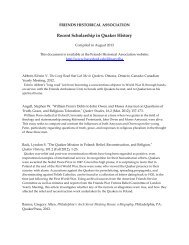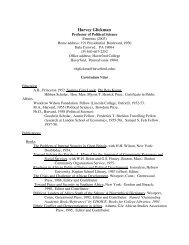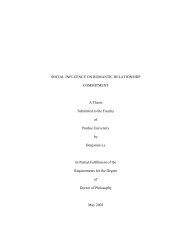Solutions
Solutions
Solutions
You also want an ePaper? Increase the reach of your titles
YUMPU automatically turns print PDFs into web optimized ePapers that Google loves.
Problems from Anton, x10.1<br />
27. Solve dy<br />
dx<br />
; xy = x, y(0) = 3.<br />
Math 120 Fall 2000|HW #8<br />
First, we rewrite the dierential equation as:<br />
dy<br />
dx<br />
Then we separate and integrate:<br />
Z<br />
dy<br />
y +1 = xdx =)<br />
Evaluating the integrals:<br />
= xy + x = x(y +1):<br />
Z<br />
dy<br />
y +1 =<br />
xdx:<br />
ln jy +1j = x2<br />
2 + C<br />
where C is any real number. Taking e to both sides:<br />
So,<br />
jy +1j = e x2<br />
2 +C = e C e x2<br />
2 :<br />
y +1=e C e x2<br />
2 =) y = e C e x2<br />
2 ; 1:<br />
We have missed one possible solution in our derivation so far we divided by<br />
y + 1 in the second step, and thus lost the constant solution y = ;1, which<br />
does indeed satisfy the original dierential equation. So, the solution to the<br />
dierential equation is:<br />
y = e C e x2 2 ; 1 or y = ;1:<br />
Since C is any real number, e C is any non-zero number, and thus we may<br />
encapsulate all of the above solutions into the simpler form:<br />
y = C 1 e x2<br />
2 ; 1<br />
where C 1 is any real number. Now, since y(0) = 3,<br />
or C 1 = 4. So,<br />
3 = C 1 e 0 ; 1<br />
y = 4e x2<br />
2 ; 1:<br />
1
43. At time t = 0, a tank contains 25 ounces of salt dissolved in 50<br />
gallons of water. Then brine containing 4 ounces of salt per gallon of<br />
brine is allowed to enter the tank at a rate of 2 gallons per minute<br />
and the mixed solution is drained from the tank at the same rate.<br />
Let s(t) be the amount of salt (in oz) present in the tank at time t. The rate of<br />
inow of salt is (2 gal/min)(4 oz/gal), or 8 oz/min. At timet, the tank contains<br />
s(t) oz of salt in 50 gal, or s oz/gal. Thus, the outow ofsalt is (2 gal/min)( s 50 50<br />
oz/gal), or s oz/min. So, the dierential equation is:<br />
25<br />
We separate and integrate:<br />
ds<br />
8 ; s<br />
25<br />
ds<br />
= 8 ; s<br />
dt 25 :<br />
= dt =)<br />
Z<br />
ds<br />
8 ; s<br />
25<br />
We perform the integration (using a u = 8 ; s<br />
25<br />
ln j8 ; s<br />
25 j<br />
;1=25<br />
=<br />
Z<br />
dt:<br />
substitution not shown here):<br />
= t + C =) ln j8 ; s<br />
25 j = ; t<br />
25 ; C 25 <br />
where C is any real number. Taking e to both sides:<br />
Thus,<br />
Now, at t = 0, s = 25, so<br />
so e ;C=25 = 7. Thus,<br />
Thus,<br />
j8 ; s<br />
25 j = e; t<br />
25 ; C 25 = e<br />
;C=25 e<br />
;t=25 :<br />
8 ; s<br />
25 = e;C=25 e ;t=25 :<br />
8 ; 25<br />
25 = e;C=25 e 0 <br />
8 ; s<br />
25 = 7e;t=25 :<br />
8 ; 7e ;t=25 = s<br />
25 =) 200 ; 175e;t=25 = s:<br />
At t = 25, s = 200 ; 175e ;1 = 135:6 ounces.<br />
2
55. Suppose that a particle moving along the x-axis encounters a<br />
resisting force that results in an acceleration of a = dv=dt = ;0:04v 2 .<br />
Given that x = 0 cm and v = 50 cm/s at time t = 0, nd the velocity<br />
v and position x as a function of t for t 0.<br />
We know that<br />
Separating and integrating:<br />
dv<br />
dt = ;0:04v2 :<br />
Z<br />
;25 dv<br />
= v dt =) ;25 dv<br />
2 v 2<br />
= Z<br />
dt =) 25<br />
where C is any real number. Since at t = 0, v = 50, we have:<br />
So,<br />
Taking one over each side:<br />
v<br />
25 = 1<br />
t + 1 2<br />
25<br />
50 = 0+C =) C = 1 2 :<br />
25<br />
To nd x, we note that v = dx<br />
dt . So,<br />
Separating and integrating:<br />
v = t + 1 2 :<br />
= 2<br />
2t +1<br />
dx<br />
= 50<br />
dt 2t +1 :<br />
dx = 50dt<br />
2t +1 =) Z<br />
v<br />
=) v =<br />
50<br />
2t +1 :<br />
dx =<br />
Z<br />
50dt<br />
2t +1 :<br />
= t + C<br />
Performing the integrals (using a substitution u = 2t +1not shown):<br />
x =<br />
50 ln j2t +1j<br />
2<br />
+ C = 25 ln(2t +1)+C:<br />
(we drop the absolute values since 2t +1 > 0 for t 0). Since x = 0 when<br />
t = 0,<br />
0 = 25 ln(1) + C =) C = 0:<br />
3
Thus,<br />
x = 25 ln(2t +1):<br />
Problems from Anton, x10.3<br />
29. A cup of water with a temperature of 95 C is placed in a room<br />
with a constant temperature 21 C. After one minute, the water is<br />
85 C. When will it be 51 C?<br />
The basic law of cooling is:<br />
dT<br />
dt<br />
= k(T ; 21):<br />
Separating and integrating:<br />
Z<br />
dT<br />
T ; 21 = kdt =)<br />
Evaluating the integrals:<br />
Z<br />
dT<br />
T ; 21 =<br />
kdt:<br />
ln jT ; 21j = kt + C<br />
where C is any real number. We know that when t = 0, T = 95, so<br />
So,<br />
ln 74 = 0+C =) C = ln 74:<br />
ln jT ; 21j = kt +ln74:<br />
We may drop the absolute values, since clearly the water temperature will<br />
always be greater than 21 C:<br />
Taking e to both sides:<br />
So,<br />
ln(T ; 21) = kt +ln74:<br />
T ; 21 = e kt+ln 74 = e ln 74 e kt = 74e kt :<br />
T = 21 + 74e kt :<br />
Now, we know that when t = 1, T = 85, so<br />
85 = 21 + 74e k =) 64<br />
74 = ek =) k = ln 64<br />
74 = ;0:1452:<br />
4
So,<br />
T = 21 + 74e ;0:1452t :<br />
Thus, to nd out when T = 51, we solve:<br />
51 = 21 + 74e ;0:1452t =) 30<br />
74 = e;0:1452t =) t =<br />
Problems from Anton, x11.3<br />
3. Determine if P 1<br />
k=1<br />
ln<br />
30<br />
74<br />
;0:1452<br />
= 6:22 min<br />
;<br />
;<br />
3<br />
4 k;1<br />
converges, and if so, nd its sum.<br />
This is a geometric series, with ratio r = ;3=4, and rst term a = ; ; 3 4 1;1<br />
= 1.<br />
So, it converges (jrj < 1), and its sum is<br />
a<br />
1;r = 1<br />
1+ 3 4<br />
= 4 7 .<br />
23. A ball is dropped from a height of 10 m. Each time it strikes<br />
the ground it bounces vertically to a height that is 3 of the preceding<br />
4<br />
height. Find the total distance the ball will travel if it is assumed to<br />
bounce innitely often.<br />
In the rst fall, the ; ball travels 10 m. In the next up-and-down, it travels 3(10)<br />
4<br />
3 2<br />
twice in the next 4<br />
(10) twice etc. Thus, the total distance is:<br />
<br />
10 + (2) 3 3<br />
2<br />
3<br />
3<br />
4 4 (10) + (2) (10) + (2) (10) + ::::<br />
4<br />
The terms excluding the rst term form a geometric series, with ratio r = 3 4<br />
and initial term a = (2) 3 a<br />
(10) = 15. Their sum is thus<br />
4 1;r = 15 = 60. So, the<br />
1; 3 4<br />
total distance is 10 + 60 = 70 m.<br />
27. In each part, nd all values of x for which the series converges,<br />
and nd the sum of the series for those values of x.<br />
a. x ; x 3 + x 5 ; x 7 + x 9 ; :::<br />
This is geometric with ratio r = ;x 2 and initial term a = x. It thus converges<br />
when jrj = j;x 2 j = x 2 < 1, i.e. when ;1 < x < 1. In that case, it converges<br />
to<br />
a<br />
1;r = x<br />
1;(;x = x<br />
2 ) 1+x<br />
. 2<br />
b.<br />
1<br />
x 2 + 2 x 3 + 4 x 4 + 8 x 5 + :::<br />
This is geometric with ratio r = 2 x and initial term a = 1 x 2 . It thus converges<br />
5
when jrj = j 2 x j = 2<br />
jxj<br />
case, it converges to<br />
< 1, i.e. when 2 < jxj, i.e. when x > 2 or x < ;2. In that<br />
a<br />
1;r = 1=x2<br />
1;2=x = 1<br />
x 2 ;2x .<br />
c. e ;x + e ;2x + e ;3x + e ;4x + :::<br />
This is geometric with ratio r = e ;x and initial term a = e ;x . It thus converges<br />
when jrj = je ;x j = e ;x < 1, i.e. when ;x < 0, i.e., when x > 0. In that case,<br />
it converges to<br />
a<br />
1;r = e;x<br />
1;e<br />
= 1<br />
;x e . x ;1<br />
29. Show that P 1<br />
; 1<br />
<br />
k=1 k ; 1<br />
k+2 =<br />
3<br />
. 2<br />
The partial sum s n simplies quite a bit by cancellation:<br />
s n =<br />
1<br />
1 ; 1 3<br />
1<br />
+<br />
+<br />
+<br />
1<br />
2 ; 1 4<br />
n ; 3 ; 1<br />
n ; 1<br />
1<br />
n ; 1 ; 1<br />
n +1<br />
<br />
<br />
= 1+ 1 2 ; 1<br />
n +1 ; 1<br />
n +2 :<br />
1<br />
3 ; 1 5<br />
+ +<br />
1<br />
+<br />
n ; 2 ; 1 n<br />
1<br />
+ ; 1<br />
n n +2<br />
By denition, the series' sum is lim n!1 s n = 1+ 1 2 = 3 2 .<br />
Problems from Anton, x11.4<br />
9. Determine whether P 1 1<br />
converges.<br />
k=1 k+6<br />
1<br />
1<br />
4 ; 1 6<br />
<br />
<br />
+ <br />
Consider the continuous, positive, decreasing function R f(x) = 1 . By the<br />
x+6<br />
1 1<br />
Integral Test, our series converges if and only if dx converges. So, we<br />
1 x+6<br />
compute:<br />
Z 1<br />
Z<br />
1<br />
L<br />
1<br />
dx = lim<br />
x +6 L!1<br />
1 x +6 dx<br />
<br />
= lim<br />
ln jx +6j j L 1<br />
L!1<br />
= lim (ln jL +6j;ln 7)<br />
L!1<br />
Since this limit does not exist, the improper integral diverges, and thus the<br />
innite series diverges.<br />
14. Determine whether P 1 ln k<br />
k=3 k<br />
converges.<br />
6
Consider the continuous, positive, decreasing function f(x) = ln x<br />
x<br />
for x 3 (to<br />
check this is decreasing, observe that f 0 x(1=x);(ln x)(1)<br />
(x) = = 1;ln x is<br />
x 2<br />
x R negative<br />
2<br />
1 ln x<br />
for x > e). By the Integral Test, our series converges if and only if<br />
3 x dx<br />
converges. So, we compute (using the substitution u = ln x):<br />
Z 1<br />
3<br />
ln x<br />
x<br />
dx = lim<br />
L!1<br />
Z L<br />
3<br />
Z ln L<br />
= lim<br />
L!1<br />
ln 3<br />
u 2<br />
= lim<br />
L!1 2<br />
ln x<br />
x dx<br />
udu<br />
<br />
ln L<br />
ln 3<br />
= lim<br />
L!1<br />
(ln L)<br />
2<br />
2<br />
!<br />
;<br />
<br />
(ln 3)2<br />
2<br />
Since this limit does not exist, the improper integral diverges, and thus the<br />
innite series diverges.<br />
18. Determine whether P 1 k 2 +1<br />
k=1 k 2 +3<br />
converges.<br />
We compute:<br />
k 2 +1<br />
lim<br />
k!1 k 2 +3 = lim<br />
2k<br />
=<br />
k!1 2k 1<br />
where the rst step is L'H^opital's Rule. Since the limit of the terms of the series<br />
is not zero, the series diverges by the Divergence Test.<br />
32a. Find the n = 10 approximation to of P 1<br />
S =<br />
k=1<br />
corresponding error bounds.<br />
1<br />
(2k+1) 2<br />
and the<br />
R 1 dx<br />
We know that if we approximate the series by s 10 + , then the error<br />
11 (2x+1) 2<br />
is greater than 0 and less than a 11 = 1 = 1 = 0:0019. Now we evaluate the<br />
(23) 2 529<br />
integral (using the substitution u = 2x + 1):<br />
Z 1<br />
Z L<br />
<br />
dx<br />
dx<br />
= lim<br />
11 (2x +1) 2 L!1<br />
11 (2x +1)<br />
Z 2 2L<br />
<br />
du=2<br />
= lim<br />
L!1<br />
23 u 2<br />
<br />
2L<br />
!<br />
= lim ; 1<br />
L!1 2u<br />
23<br />
<br />
= lim ; 1 + 1<br />
L!1 4L 46<br />
7<br />
<br />
= 1<br />
44
Next, we evaluate the tenth partial sum:<br />
s 10 = 1 3 2 + 1 5 2 + 1 7 2 + 1 9 2 + 1<br />
(11) 2 + 1<br />
(13) 2 + 1<br />
(15) 2 + 1<br />
(17) 2 + 1<br />
(19) 2 + 1<br />
(21) 2 = 0:2110:<br />
Our approximation is therefore 0:2110 + 1 = 0:2327. Thus, the innite series<br />
46<br />
is between 0:2327 and 0:2327 + 0:0019 = 0:2346.<br />
33. Approximate P 1 1<br />
k=1 k<br />
to within 0.01.<br />
3<br />
R 1 dx<br />
We know that if we approximate the series by s n +<br />
n+1 x<br />
, then the error is<br />
3<br />
greater than 0 and less than a n+1 = 1 . We want to choose<br />
(n+1) 3 n great enough<br />
so the width of this error bound is less than<br />
p<br />
0.01. In other words, we want<br />
1<br />
(n+1) 3 < 0:01, or (n +1) 3 > 100, or n +1> 3 100 = 4:64, or n > 3:64. So, we<br />
choose n = 4. Thus, our approximation is:<br />
1X<br />
k=1<br />
1<br />
k 3 s 4 +<br />
Z 1<br />
dx<br />
5<br />
x 3<br />
= 1 1 + 1 2 3 + 1 3 3 + 1 4 3 + x;2<br />
;2<br />
= 1:1777 ; 1<br />
2x 2 <br />
1<br />
<br />
1<br />
5<br />
= 1:1777 ; 0+ 1<br />
2(25) = 1:1977<br />
So, the sum of the innite series is between 1:1977 and 1:1977 + a 5 = 1:1977 +<br />
1<br />
5 3 = 1:2057.<br />
5<br />
8



